valeg96
Hazard to Others
  
Posts: 253
Registered: 6-4-2014
Location: Italy
Member Is Offline
Mood: Moodless
|
|
Preparation of Cerium (IV) sulfate anh. from CeO2 (OTC Chem)
Note: this is the translation of a post I made on another forum back in 2018, which I abandoned, but still survives in the webs of the
internet.
Introduction
The most common and cheapest lanthanoid for the home chemist, is, without doubt, Cerium. While Neodymium can of course be found almost for free in
magnets, its isolation and purification can quickly become an obnoxious and wasteful task. Ce, on the other hand, can be purchased for little money as
nearly-pure Ce(IV) oxide, ceria, CeO2, a polishing powder.
Cerium can be useful due to its high reduction potential of the pair Ce(IV)/Ce(III) , around +1.4/+1.6 V depending on the specific salt and on the
acidity of the solution, and is thus a good oxidant in analytical chemistry, for reactions such as those with the pair Fe(II)/Fe(III). Cerimetric
titrations are technically accessible to the home chemist, if not for the high price of Ce(IV) salts (1 kg Ce(IV) ammonium nitrate by Scharlau, a
relatively cheap brand, is 500€) and the niche indicators (ferroin).
With this preparation it is possible to bypass the first obstacle, by making a very cheap and simple Ce(IV) salt according to an old procedure from 1904 by Meyer and Aufrecht, starting from CeO2. Commonly sold as polishing ceria powder, it can be quickly and
safely sourced on ebay or aliexpress for as little as 5 € for 60 g: some sellers claim a decent purity (mine is 99.6% CeO2), but if this
is not available, seek a product with reviews, photos or a list of ingredients to make sure it is at least white/yellowish and does not contain other
additives: pink, purple, orange or red products are most likely contaminated with either other lanthanoids, or with polishing additives. There seem to
be no common agreement on the actual colour of CeO2. The kind you find for polishing purposes is a dense, inert, calcined white-cream-ivory powder
with a possible slightly vanilla-custard yellowish tinge, so if you are sold a red powder that dissolves or fizzes in hydrochloric acid, or dissolves
in water, it's either filled with additives, or something else.
This procedure was attempted, though in a slightly different setting, by SM user Lion850. The details are in this thread. Since my original work dates back to 2018 and it's a fairly complete summary of the procedure, I decided to post it independently in
Prepublication. Nonetheless, Lion850's thread deals with an additional cerium salt: basic cerium sulphate, so I suggest you check out his work as
well. As Lion850 mentions, and as I found out back in 2018, calcined, inert CeO2 is completely unreactive towards hot and cold HCl and
HNO3, so hot H2SO4 is the only effective route. Some very old sources, like the Mellor, say that ceria is soluble in
hot HCl, but it seems like the material you can source nowadays is calcined to absolute inertness.
Chemicals and Equipment
Cerium (IV) oxide
Sulphuric acid, > 96%
Acetic acid, Glacial and/or Ethanol, 96%
Conical flask and reflux condenser
Buchner funnel, or Gooch funnel, and vacuum pump.
Brief overview
The reaction employed is the direct conversion of Ce(IV) oxide into Ce(IV) sulphate. Thanks to the reaction environment, the salt is nearly anhydrous,
so once everything is done, it is mainly a feat of speed and cleanliness during the filtration and washing of the product. If a hydrated product is
desired, there's less to worry about. The anhydrous salt is a bright lemon-yellow salt, slightly hygroscopic, that hydrates to the orange tetrahydrate
form. Regardless, it is not a heat-sensitive material so it can be dried on a hotplate without decomposition.
CeO2 + 2 H2SO4 → Ce(SO4)2 + 2 H2O
The reaction is carried out in a strong excess of concentrated sulphuric acid, with vigorous stirring, and boiling temperatures. The original article
talks about actual refluxing (!) but the reaction takes little time and the yield is virtually quantitative. Glacial acetic acid or ethanol are used
to soften the reaction products when their density is excessive, and to wash the final product. I personally suggest ethanol, as it's cheaper, and
less outrageous to the nose.
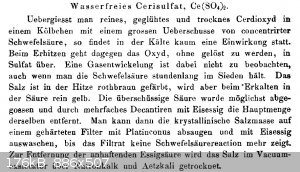
All of the wet mixtures, pastes, humid products, mushy salts and solutions involved in this preparation will ruin effortlessly any kind of stainless
steel spatula or tool on touch, so if you need to use any, be quick and rinse them immediately.
Experimental
In a 100 mL conical flask are placed CeO2 (4 g) and 96% sulfuric acid, (12 mL, 300% excess). A water-cooled condenser is attached, and the
mixture heated to around boiling point with very vigorous stirring. In less than 30', and with the increasing temperature, the mixture goes from pale
yellow, to sulphur yellow, then orange, and finally, a dense brick-red paste.
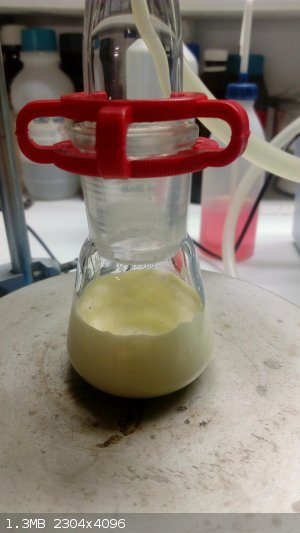 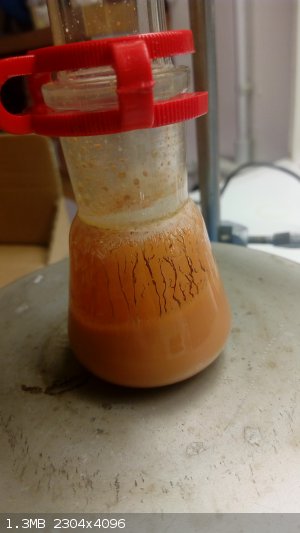
After cooling, the paste is made more fluid with 50 mL of glacial acetic acid or 96% ethanol (I suggest the latter). The solution is decanted from the
lemon-yellow precipitate, and the solid is filtered on a Buchner or a Gooch funnel, and washed with plenty of glacial acetic acid, or 96% ethanol.
Needless to say, I again suggest the latter. The filter cake is then quickly placed in a vacuum desiccator, or in a standard desiccator. If you used
acetic acid, drying on NaOH may just be the best option. In the third photo below you can see a tiny amount of the product left to hydrate in a couple
of drops of alcohol, yielding the orange tetrahydrate. Additionally, since what you filter is room-temperature sulphuric acid diluted in either
ethanol or acetic acid, it is recommended that you either use a glass wool filter, or if you use paper, you do not place it in the desiccator along
the product (just scrape it off as soon as the filtering is done): the paper will eventually disintegrate, and you do not want a product mixed with
cellulose powder and mystery carbohydrates.
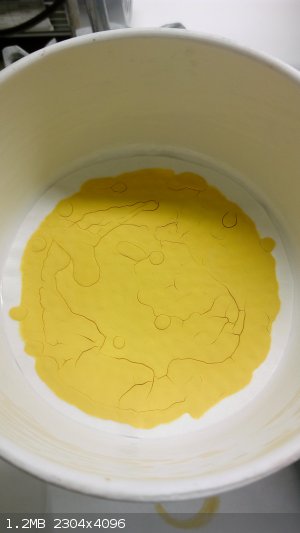 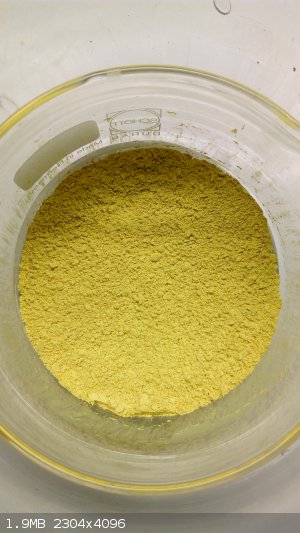 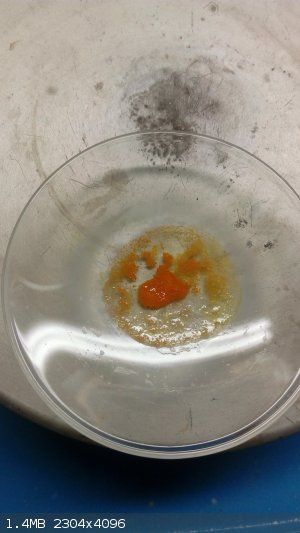
I started from 4.7766 g / 172.1148 g/mol of CeO2 = 27.7524 mmol.
Theoretical yield: 27.7524 mmol * 0.332304 g/mmol = 9.222233 g of anh. Ce(SO4)2.
Actual yield: 8.4477 g
% yield: 91.61%
[Edited on 30-4-2020 by valeg96]
[Edited on 30-4-2020 by valeg96]
[Edited on 30-4-2020 by valeg96]
[Edited on 30-4-2020 by valeg96]
[Edited on 30-4-2020 by valeg96]
|
|
|
Lion850
National Hazard
   
Posts: 514
Registered: 7-10-2019
Location: Australia
Member Is Offline
Mood: Great
|
|
Hi Valeg good report. I did something similar a while ago, see
https://www.sciencemadness.org/whisper/viewthread.php?tid=15...
It seems that the temperature of the sulphuric acid determines whether one ends up with the basic sulphate of the proper anhydrous Ce(SO4)2; you can
see photos of both in my post as per above link. Maybe Admin can combine our posts to have all the info in one thread.
|
|
|
valeg96
Hazard to Others
  
Posts: 253
Registered: 6-4-2014
Location: Italy
Member Is Offline
Mood: Moodless
|
|
Yes, I saw your thread, but I decided to post mine separately in the prepublication section, as I already had the whole text, explanations,
introduction, hints and photos ready for it as an independent submission. I just had to quickly translate it to English.
|
|
|
Lion850
National Hazard
   
Posts: 514
Registered: 7-10-2019
Location: Australia
Member Is Offline
Mood: Great
|
|
Oops I did not even notice it was in a different section, as I jumped to your post from "Today's posts".
|
|
|
j_sum1
Administrator
       
Posts: 6219
Registered: 4-10-2014
Location: Unmoved
Member Is Offline
Mood: Organised
|
|
Nice work.
Lion, I have quite a bit if your work still to read. You have been very productive and I have been otherwise occupied. (A broken pelvis and two
coronavirus quarantines can do that.)
I think there is little harm in having both threads active. But it might be good if there is a link from one to the other.
I have 200g of ceria. This procedure looks very attractive to me. As soon as I am able to be active in the lab again. Thanks to both of you.
|
|
|
valeg96
Hazard to Others
  
Posts: 253
Registered: 6-4-2014
Location: Italy
Member Is Offline
Mood: Moodless
|
|
Thanks. I'll link the earlier (post-wise, at least) work by Lion850 in a fit way. Also, Lion, you may find that the original article deals with much
more than this simple anhydrous salt, and talks about other basic sulphates or mixed cerium salts. Unfortunately it's in German, but you might find
some answers to your original work.
Modesty aside, j_sum1, you are absolutely right: I believe this is one of the most attractive things you can do in a home lab. It's stunning how you
can make an expensive and borderline exotic reagent (and afterwards the whole family of Ce(IV) salts) with cheap OTC chemicals in less than an hour.
Unfortunately, most of my work revolves around Cu(II), Ni(II), Co(II) and Co(III) salts and complexes, and I couldn't find any detailed procedure to
turn this into ceric ammonium sulphate, so I just stored it away in a dark vial and carried on with my beloved cobalt.
|
|
|
Lion850
National Hazard
   
Posts: 514
Registered: 7-10-2019
Location: Australia
Member Is Offline
Mood: Great
|
|
Quote: Originally posted by j_sum1  | Nice work.
Lion, I have quite a bit if your work still to read. You have been very productive and I have been otherwise occupied. (A broken pelvis and two
coronavirus quarantines can do that.)
I think there is little harm in having both threads active. But it might be good if there is a link from one to the other.
I have 200g of ceria. This procedure looks very attractive to me. As soon as I am able to be active in the lab again. Thanks to both of you.
|
Mate I hope things are all Ok again your side! My job is stuffed as I cannot travel overseas so I tried to spend an hour or two in the shed every day

|
|
|
|